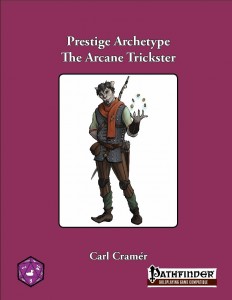Prestige Archetypes: The Arcane Trickster
Prestige Archetypes: The Arcane Trickster
This installment of the Prestige Archetype-series clocks in at 11 pages, 1 page front cover, 1 page SRD, ~1/2 a page of editorial, leaving us with 8 1/2 pages of content, so let’s take a look!
First question – what are prestige archetypes? Well, they are essentially a breakdown of a regular PrC into a full-blown 20-level spanning class – so no, these classes don’t necessarily mean that you’ll have a universal archetype (wouldn’t have worked in this context, I think), instead providing a retooled playing experience so you don’t have to work your way up to the PrC via classes you don’t want to play. So that’s definitely a pro-side. On the con-side, *personally*, I treat PrCs as very much tied to organizations etc., emphasizing the “prestige”-component as opposed to archetypes, which are more traditions in my game. I’m not the target audience of these books, but I will take a stab at them anyways.
The arcane trickster in its base class guise receives d8, 4+Int skills per level (OUCH), proficiency with simple weapons + hand crossbow, rapier, sap, shortbow and short sword, but not with any armor (which interferes with casting) as well as prepared spellcasting from the wiz/sorc-list of up to 6th level.The class has 3/4 BAB-progression and good ref- and will-saves. Spellcasting begins at first level with only 3 cantrips + 1 1st level spell and both scribe scroll and trapfinding are relegated to 2nd level. The signature ranged legerdemain is granted at 1st level, though – thankfully!
At 3rd level, evasion and sneak attack are gained, with the latter scaling up by +1d6 every 2 levels thereafter, to a maximum of +9d6. At 4th level and every 4 levels thereafter, the arcane trickster receives a rogue talent, with a list of thematically appropriate talents being provided – this list also constituting a potential way for DMs to balance the class versus the base rogue – just limit the class to the talents provided. Now what’s pretty odd – arcane bond is gained at 6th level – which isn’t weird balance-wise, but the additional imposed requirement to make concentration-checks to cast sans the object makes no sense in this case as opposed to regular casters gaining it at 1st level – so far the arcane trickster could cast without it, so where’s the dependency coming from? See, that’s one issue with re-appropriating such components and one that imho should be addressed.
Tricky Spells (free silent and still spell) is learned at 6th level 1/day, +1 every 3 levels thereafter. Impromptu Sneak Attack is gained at 10th level, 2/day at 14th level. On a nitpicky side, the ability works with ranged attacks and thus circumvents the usual range-restriction for sneak attack.
At 14th level, surprise spells are gained, with sneak attack of the spell’s damage type being added – the original’s potential ambiguity regarding the use of magic missile etc. unfortunately remaining. To spare you the research – it’s only added to one target of AoE-spells, one magic missile, etc. – no spamming of sneak attack. And then there’s the potential confusing with spells that can have a crit modifier greater than x2 – while there aren’t many, they exist – so sneak attack bonus damage x2 or x3?
At 16th level, advanced talents enter the fray – now so far, I’ve kept quiet about talents and they do represent an interesting selection from both Paizo-core and 3pps, including the advanced talent option to temporarily render a sneaked target incapable of executing AoOs. Per se, a cool array, including less costs for trapsmithing hide in plain sight and dispelling attacks. At 18th level, the arcane trickster can become greater invisible as a free action as a spell-like ability for class level rounds/day.
The pdf comes with FCOs for the core races and a sample NPC-build at 1st, 5th, 10th and 15th level.
Conclusion:
Editing and formatting are very good, I noticed no truly significant glitches. Layout adheres to Purple Duck Games printer-friendly two-column standard and the pdf comes fully bookmarked for your convenience.
Carl Cramér’s arcane trickster can be considered one of those prestige archetypes that immensely benefit from being changed to 20-level-classes – let’s face it, making the arcane trickster a PrC was always a sucky move, forcing the player to play two totally disparate classes before finally getting to do what s/he wanted in the first place. So yeah, I *really* want to love this prestige archetype – it’s generally pretty well-crafted, but it does have some rough edges – like the lack of a capstone. The weird arcane object-design choice or the impromptu sneak attack-range glitch, the lack of streamlined wording for surprise spells…all of these conspire to drag down what generally is a great class – and usually, I’d go 3 stars. BUT, this is the arcane trickster I always wanted – pretty strong and capable, perhaps too much so in certain campaigns. I’d certainly advise DMs allowing this one to restrict its talent-selection vs. rogues in order to maintain some reason for the latter to exist. That being said, I do consider this a pretty good, if not perfect take on the arcane trickster, well worth a final rating of 3.5 stars, rounded up to 4 for the purpose of this platform.
You can get this solid take on the arcane trickster as a base class here on OBS and here on d20pfsrd.com’s shop.
Endzeitgeist out.

